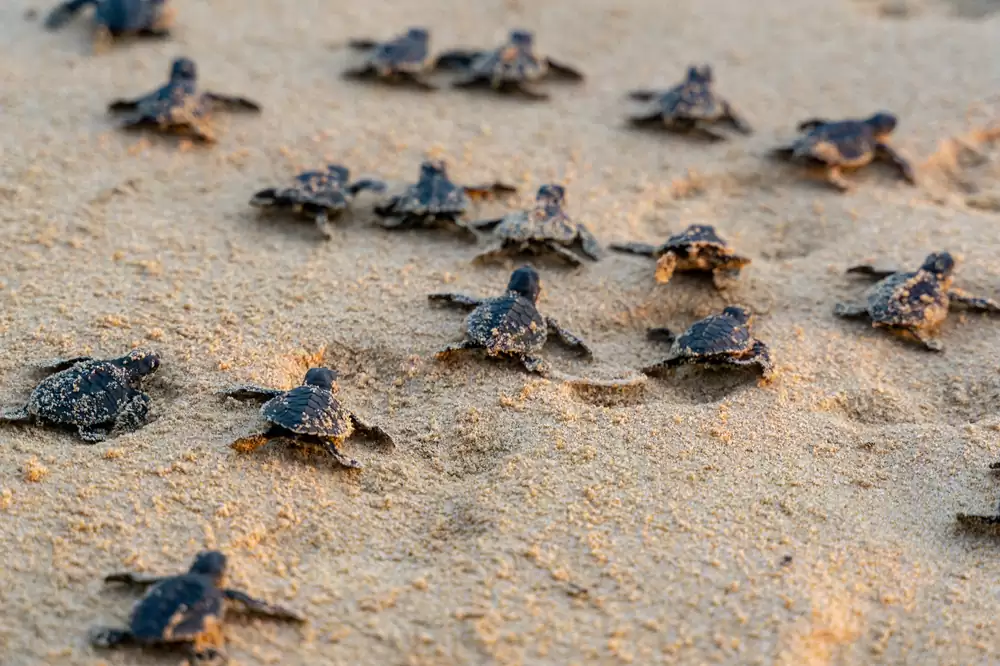Tulum, Quintana Roo — With the first loggerhead turtle nest already discovered in Cozumel, the 2025 sea turtle nesting season is officially underway across the Mexican Caribbean. From May to October, over 42 civil and governmental institutions will be working together to protect these ancient mariners as they return to the beaches of Quintana Roo to lay their eggs—a ritual that has been repeated for millions of years.
Early Activity in Cozumel
The first nest of the season was recorded at Punta Sur Eco-Park by the team from the Sea Turtle Camp of the Cozumel Parks and Museums Foundation (FPMC). Alongside the fresh tracks of a loggerhead turtle (Caretta caretta), this early activity signals the start of what conservationists hope will be another successful season.
Itandehui Ramos Bautista, president of the Committee for the Protection, Conservation, Research, and Management of Sea Turtles in Quintana Roo, confirmed that four species make their nests here:
- Green turtle (Chelonia mydas)
- Loggerhead turtle (Caretta caretta)
- Hawksbill turtle (Eretmochelys imbricata)
- Leatherback turtle (Dermochelys coriacea)
“Our camps are ready to protect every nest, thanks to the joint efforts of field technicians, students, and volunteers,” Ramos Bautista explained.

Key Nesting Hotspots in Quintana Roo
Sea turtles favor many beaches across the region, with key nesting areas including:
- Cancún: Playa Delfines, Playa Marlin, and Playa Chac Mool
- Riviera Maya: Xpu-Ha, Akumal Bay (famous for snorkel encounters), and Xcacel-Xcacelito
- Cozumel: Punta Sur and Playa San Martín
- Isla Mujeres: Playa Norte and Sac Bajo beaches
Each site plays a critical role in supporting the life cycle of these species, which migrate thousands of miles but always return to the same beach where they were born to nest.
Understanding the Sea Turtle Life Cycle
After mating offshore, female turtles crawl ashore under cover of night, dig a deep nest, and lay up to 100 eggs. About 45 to 70 days later, tiny hatchlings emerge and scramble toward the sea—an incredible but perilous journey where only an estimated one in 1,000 will survive to adulthood.
The cycle is delicate: hatchlings can become disoriented by artificial lights, and adult females can abandon nesting attempts if beaches are too noisy or disturbed.
How You Can Help
Everyone can play a part in ensuring these incredible creatures continue to thrive:
- Keep beaches clean: Litter and debris can trap hatchlings or deter nesting mothers.
- Avoid using lights near nesting beaches at night: Bright lights disorient both nesting females and emerging hatchlings.
- Respect marked nesting areas and obey posted signs. Never walk over or disturb a marked nest.
- Participate in beach cleanups: Groups like Cozumel’s FPMC, Akumal Ecological Center (CEA), and local turtle camps often organize public cleanup events.
- Volunteer with turtle conservation programs: Many camps in Playa del Carmen, Tulum, and Isla Mujeres welcome volunteers during the season.
- Never consume turtle meat, eggs, or products: It’s illegal in Mexico and threatens already endangered species.
- Report nest sightings to local conservation groups or authorities if you spot one unprotected.
A Shared Responsibility
“Conserving sea turtles is everyone’s responsibility,” emphasized Ramos Bautista. “Protecting their habitat and breaking the chain of illegal activities are key to their survival.”
The nesting season is not just an opportunity for scientific study—it’s a time for communities and visitors to connect with one of the ocean’s most ancient and awe-inspiring creatures. Through education, respect, and collaboration, Quintana Roo is reinforcing its commitment to preserving biodiversity and ensuring that future generations can witness the wonder of turtles returning to their ancestral beaches.
Discover more from Riviera Maya News & Events
Subscribe to get the latest posts sent to your email.
